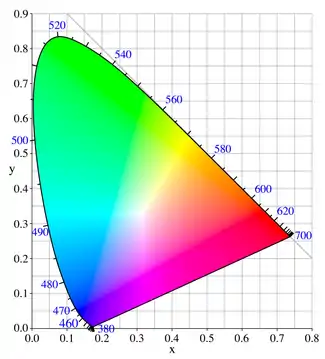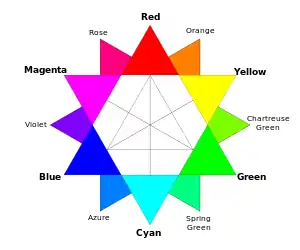International Commission on Illumination
The International Commission on Illumination (usually abbreviated CIE for its French name, Commission internationale de l'éclairage) is the international authority on light, illumination, colour, and colour spaces. It was established in 1913 as a successor to the Commission Internationale de Photométrie, which was founded in 1900, and is today based in Vienna, Austria. The President from 2019 is Dr Peter Blattner from Switzerland.[1]
| Abbreviation | CIE |
|---|---|
| Formation | 1913 |
| Type | INGO |
| Location |
|
Region served | Worldwide |
Official language | English, French |
President | Peter Blattner Switzerland |
| Website | CIE Official website |

The CIE 1931 colour space chromaticity diagram with wavelengths in nanometers. The colours depicted depend on the colour space of the device on which the image is viewed.
Organization
The CIE has six divisions, each of which establishes technical committees to carry out its program under the supervision of the division's director (depending):
- Division 1: Vision and Colour
- Division 2: Physical Measurement of Light and Radiation
- Division 3: Interior Environment and Lighting Design
- Division 4: Transportation and Exterior Applications
- Division 6: Photobiology and Photochemistry
- Division 8: Image Technology
Division 5 (Exterior Lighting and Other Applications) and Division 7 (General Aspects of Lighting) are inactive today.
Milestones
- In 1924 it established the standard photopic observer defined by the spectral luminous efficiency function V(λ), followed in 1951 by the standard scotopic observer defined by the function V’(λ).
- Building on the Optical Society of America's report on colorimetry in 1922,[2] the CIE convened its eighth session in 1931, with the intention of establishing an international agreement on colorimetric specifications and updating the OSA's 1922 recommendations based on the developments during the past decade.[3] The meeting, held in Cambridge, United Kingdom, concluded with the formalization of the CIE 1931 XYZ colour space and definitions of the 1931 CIE 2° standard observer with the corresponding colour matching functions, and standard illuminants A, B, and C.
- In 1964 the 10° CIE standard observer and its corresponding colour matching functions as well as the new standard daylight illuminant D6500 were added, as well as a method for calculating daylight illuminants at correlated colour temperatures other than 6500 kelvins.
- In 1976, the commission developed the CIELAB and CIELUV colour spaces, which are widely used today.
- Based on CIELAB, colour difference formulas CIEDE94 and CIEDE2000 were recommended in the corresponding years.
See also
References
- CIE Board of Administration Archived 2016-04-16 at the Wayback Machine. Retrieved 07/07/2015.
- Troland, L. T. (August 1922). "Report of Committee on Colorimetry for 1920–21". Journal of the Optical Society of America. 6 (6): 527–96. doi:10.1364/JOSA.6.000527. The report defined colour as follows: "Colour is the general name for all sensations arising from the activity of the retina of the eye and its attached nervous mechanisms, this activity being, in nearly every case in the normal individual, a specific response to radiant energy of certain wave-lengths and intensities."
- Jones, L. A. (1943). "Historical background and evolution of the colorimetry report". Journal of the Optical Society of America. 33 (10): 534–43. doi:10.1364/JOSA.33.000534.
This article is issued from Wikipedia. The text is licensed under Creative Commons - Attribution - Sharealike. Additional terms may apply for the media files.
